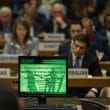A new international biorisks organization is needed to ensure security
By Pal Aas, June 17, 2008
Ralf Trapp clarified my concerns and points to the core of the problem: determining what chemicals are for law enforcement and which legal interpretations States Parties to the Chemical Weapons Convention (CWC) will accept?
Recent advances in biotechnology are outstripping legal and normative safeguards designed to protect us from the misuse of new technologies. This is why governments should introduce new international regulatory structures to ensure that terrorists and proliferators do not use the bio-sciences to acquire pathogenic materials. Most governments seem to lack the ability to address more than one risk at a time. Nuclear proliferation has for a long time held politicians' and the mainstream media's focus, but it is time to broaden that focus to include emerging bio-risks. An example of a trend that warrants attention is the mail-order "biofab" companies described by Jonathan Tucker. These labs are possible sources of new pieces of genetic information, and they are accessible to anyone.
An international control regime is the only option for covering the large area of biotechnology. Trusting such a regime might at first glance seem naive because of the difficult task of comprehensively verifying activities. But there are few alternatives other than international inspection and verification based on regular declarations. The international community needs an institutional framework to manage biorisks in broad terms, similarly to the way the Organisation for the Prohibition of Chemical Weapons controls chemical agents and non-living toxic chemicals. Therefore, I endorse Tucker's proposal for a new international body that has as its highest priority to coordinate biosecurity in broad terms. Such a body would work closely with other organizations such as the World Health Organization, which has established international standards for the safe and secure handling of pathogens.
No state or states can tackle this challenge on their own–not the European Union, the United States, or the Russian Federation. And the threat is too diverse for solutions to be carried out on an ad hoc basis. Scientists from across the globe need to be involved in the development process at an early stage and the intersessional Biological Weapons and Toxins Convention meetings are a good place to start.
On the issue of "chemicals for law-enforcement," Alan Pearson worries that declarations would not cover all incapacitating agents or that they would not even cover most of them. Clear definitions, rules, and criteria will have to be negotiated and agreed-upon. There are many issues of concern, but two are particularly important: the definition of the words "toxic chemicals" and "weaponization." In my mind, chemicals for law enforcement purposes are not weaponized according to the obligations and definitions of the CWC; these agents do, however, use a delivery or dispersion system. To me, only chemical warfare agents are weaponized. Permitted law-enforcement chemicals have to follow agreed-upon criteria. Such criteria probably will permit States Parties to use a broader range of chemical agents for law enforcement purposes than they presently do. This is why an international group should define the permitted types, numbers, and quantities, and why the stockpiles should be subject to international control.
Topics: Biosecurity
Share: [addthis tool="addthis_inline_share_toolbox"]














